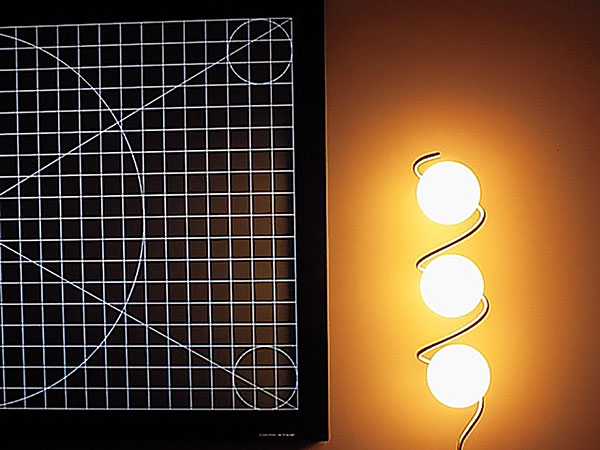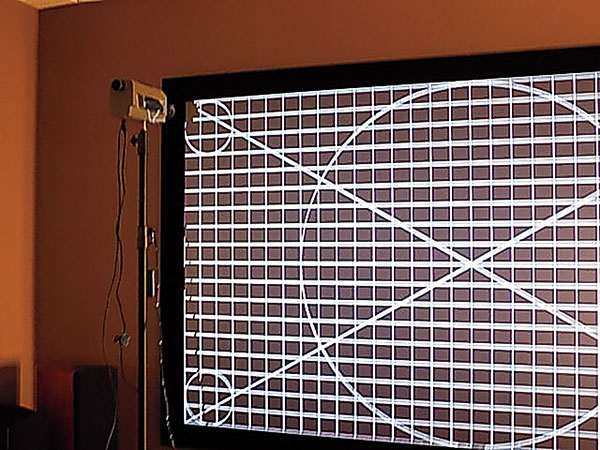Elite Prime Vision DarkStar 9 Projection Screen Review Page 2
For my review, the DarkStar 9 was wall-mounted in a completely light-controlled theater environment, with a door allowing daylight to sift in when necessary for testing. Additionally, I positioned various types of lighting above, under, and next to the screen to analyze its rejection capabilities. A floorstanding, incandescent lamp with three 60-watt globes was placed 24 inches from the right edge of the viewing surface and 12 inches perpendicular to the screen wall. Light emission from the three globes cast evenly across most of the right third of the screen. I rigged a tubular fluorescent trouble light from the ceiling, 12 inches from the wall junction at screen center, to cast light downward. Below, an LED fixture with a pretense to “daylight” color temperature was able to illuminate up from the screen bottom, testing the optical vertical filters in that domain. Although far from a scientific enterprise, these three types of ambient light plus a sunlight path from the outside sufficiently tasked the DarkStar material. Into my Oppo BDP-103 universal disc player went Rush’s Snakes & Arrows Live, a tour de force 1.78:1 Blu-ray that I maintain is easily reference quality.

One by one, each type of light lashed out at the DarkStar 9, and only the incandescent fixture (the floorstander by the screen’s right edge) dimmed the image to any degree. That happened when the image depicted the stage lighting being lowered between songs. But whenever the stage was seemingly afire from lasers, spotlights, and (occasionally) real fire, the DarkStar 9 punched out the image with the same authority that Alex Lifeson’s Hughes & Kettner amps dealt his guitar riffs. From above and below the screen, each lamp had no identifiable effect I could spot from an appropriate viewing distance. When I moved closer into the incident angle of reflection, washout occurred, reinforcing EPV’s caution regarding throw distance.


I’m no Carl Sagan, but I confirmed to my own satisfaction that the DarkStar 9 material delivers as promised on vertical ambient light rejection and is pleasantly effective in the horizontal plane, handling mildly unavoidable light leakage.
DarkStar-Gazing
I now turned to what only a few years back would have appeared to be logically incongruent: using an ambient light–rejecting screen in an environment devoid of ambient light. (Sorry, Mr. Spock!)
With the lights turned off for traditional dark-room theater viewing, I placed into the Oppo’s tray the 2004 film adaptation of the musical The Phantom of the Opera. In chapter 3 at 9:33, Monsieur Lefèvre proceeds with turning over the Opéra Populaire to Mssrs. Firmin and André. Underneath the layer of his overcoat, Lefèvre’s suit jacket is visible. In my viewing notes, I wrote, “I’ve seen this passage hundreds of times; never noticed the raised velvet pattern on the suit. The texture is stunning with black gradients.” A few minutes passed before I was interrupted by friends, curious about what I was doing. I invited them in, while cueing up another point of reference. Hearing it was Phantom, they gave up a collective “ugggh” (these friends being of the rock-’em-sock-’em ilk). Pressing play for chapter 14 at 55:05, I summoned the scene where Carlotta (Minnie Driver) is in a pink mink wrap and a lace-strewn hat that’s appropriately flowered and sporting a feather. The “ugggh” pivoted to “Holy jumpin’! That’s amazing! I can’t believe how spectacular that looks! How much is this?” Not exactly the type of seminal moment that ends world conflicts, though it might be in the zip code of “build it, and they will come.”
What it reinforced for me is that a little powerhouse projector like the Epson PowerLite Home Cinema 3500, when coupled with a high- technology screen, can dance around the price ranges occupied today by 75- to 80-inch flat panels. While those are UHD 4K (and in this instance, the Epson is 1080p), the glare-free, large impact of a partnership like this is mighty compelling; indeed, there are much worse ways to await the 4K rollout. As Phantom continued and Christine got set to replace Carlotta on stage, I changed viewing angles at various radiuses around the screen. My notes point out “no apparent loss of luminance, nothing amiss color-wise; black level solid anywhere the screen is viewable.”
I followed with Pixar’s Cars, the beginning a splendid way to test black level. As the soundtrack keeps us aurally captive on the infield at a “hot” racetrack, the image remains black. During that span, the Epson 3500 revealed its performance frailty of weak black level—no fault of the screen. Moments later, a lightning burst of color places you behind a cartoon windshield, catapulting down asphalt. Once more, it goes black; Lightning McQueen’s voice searches deep inside for the confidence needed to conquer the checkered flag. What the DarkStar 9’s contrast increase does exceptionally well is pull the active image dimensionally forward in such a way that black bars retreat nicely to the background, though without fully disappearing on a projector with limited contrast like this Epson. On a projector with deeper native blacks and higher contrast, it probably wouldn’t be necessary to mention black bars, as they likely would be absent on most scenes.
Another intriguing benefit of the DarkStar 9 in dark-room viewing is that its design, which focuses the projector’s light directly back at the viewer, minimizes the typical effect of reflected screen light energizing the side walls. This further enhances contrast.
To the 9s
The Elite Prime Vision DarkStar 9 has a split personality, and both of its personas are equally appealing. With judicious placement that avoids having ambient light fall directly on the screen, it offers the option of enjoying a dramatically larger glare-free image than that of many flat panels at or near the combined ticket of a DarkStar 9 plus a budget-priced (under $2,000) high-light-output projector. While this screen tallies a bit north of $3,000 all by itself, the technology involved and the results it coaxes from the source definitely command comparison with other screens making similar claims. I feel confident calling the DarkStar 9 a
top contender in overall ALR performance.
Where the DarkStar 9 will have you completely rethinking your approach to screens, however, is in its use for light-controlled theater environments. Any projector will benefit from the ultra-wide viewing angle, which at the same time retains uniformity. Add in enhanced contrast with ocean-deep black levels, flat spectral response, and accurate color fidelity, and you’ve got an ALR screen that can clearly serve double duty when the lights go down. The DarkStar 9 earns my enthusiastic recommendation.
- Log in or register to post comments


























































